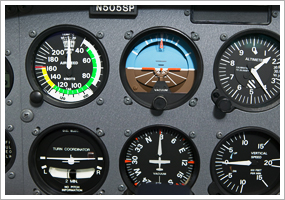| The following stories from the April 16, 2010, edition of AOPA ePilot were provided to AOPA members who expressed an interest in the particular subject areas. Any AOPA member can receive information tailored to their areas of interest by updating their preferences online. TRAINING TIPsStall recognition What indications does your aircraft give that it is about to stall? It’s good and necessary for a pilot to be able to recover properly from an incipient or full stall. But there’s a higher level of skill and awareness in being able to recognize the developing deterioration of aerodynamic performance. That skill boosts safety—and satisfies the knowledge requirement for your practical test.
When you think about the indications your aircraft may provide that it is about to stall, don’t just content yourself with automated warnings such as a stall horn or visual display. Your ability to sense your aircraft’s aerodynamic condition could be your first alert—and after all, warning systems might fail. As described in the Private Pilot Practical Test Standards’ power-off stalls task, satisfactory performance is achieved when the applicant “recognizes and recovers promptly after the stall occurs by simultaneously reducing the angle of attack, increasing power to maximum allowable, and leveling the wings to return to a straight-and-level flight attitude with a minimum loss of altitude appropriate for the airplane.” How you recognize the stall does not depend on mechanical indications. Many stall warning systems are designed to activate a few knots before stall occurs.
If you had plenty of quality training maneuvering during slow flight, you’ll know how your trainer responds. Ralph Butcher took up this subject in his January 2003 Flight Training “Insights” column. See his list of aerodynamic demonstrations that sharpen stall-recognition skills.
Stall recognition is a natural extension of a pilot’s overall airspeed awareness. That’s the ability to “fly by feel.” If you have this knack, you can make fair estimates of airspeed based on control effectiveness, and how much adverse yaw (aileron drag) occurs during maneuvers. Airspeed awareness was reviewed in the Feb. 15, 2002, “Training Tip.” “Such skills enhance safety, providing sensory clues to aid in stall recognition and avoidance. They reduce pilot workload. They enhance passenger comfort, because the smoothness of the pilot becomes the smoothness of the ride,” it said.
That’s a lot of benefit for mastering one fundamental skill. More than just something to ace for a flight test, showing your stall recognition smarts guarantees that pilot and aircraft are truly functioning as one. TRAINING PRODUCTSSporty’s Flight DeskSporty’s Pilot Shop recently introduced a slim, convenient way to carry both a kneeboard and a flight bag. The Deluxe Flight Desk looks like a zippered binder, but it opens to reveal places for charts, notes, and approach plates. There are lots of pockets to store items you might need quickly as well. The Deluxe Flight Desk sells for $39.95. FINAL EXAMQuestion: How do I know when a crosswind is too strong for me to land my aircraft safely? Answer: You might want to begin by determining the crosswind component for the runway on which you intend to take off or land. The crosswind component is the wind component measured in knots at 90 degrees to the longitudinal axis of the runway. You can find both the headwind and crosswind component using a crosswind component chart. Next, you can determine whether or not this value exceeds the maximum demonstrated crosswind component of the aircraft you are flying. Most manufacturers will furnish that value in the pilot's operating handbook or flight manual. The maximum demonstrated crosswind component lets you know the airplane can handle at least the listed amount of crosswind. Finally, don't forget to figure in your own capabilities and experience as a pilot. The aircraft may be able to handle a stronger crosswind than you can. For more information on crosswinds and operations in windy weather, see AOPA’s subject report Windy Flight Operations, and read the AOPA Air Safety Foundation’s Safety Advisor, Mastering Takeoffs and Landings . Got a question for our technical services staff? E-mail [email protected] or call the Pilot Information Center, 800/872-2672. Don’t forget the online archive of “Final Exam” questions and answers, searchable by keyword or topic. |



